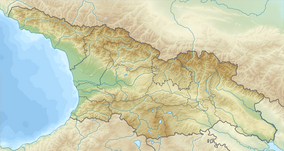Tskaltsitela Gorge Natural Monument
| Tskaltsitela Gorge Natural Monument | |
|---|---|
| Tskaltsitela Ravine Natural Monument | |
 Tskaltsitela river canyon. | |
 | |
| Location | |
| Nearest city | Kutaisi |
| Coordinates | 42°16′40″N 42°45′22″E / 42.27778°N 42.75611°ECoordinates: 42°16′40″N 42°45′22″E / 42.27778°N 42.75611°E |
| Area | 0.22 km2 (0.085 sq mi) |
| Established | 2007 |
| Governing body | Agency of Protected Areas |
| Website | Natural Monument |
Tskaltsitela Gorge Natural Monument (Georgian: წყალწითელას ხეობის ბუნების ძეგლი) is a river gorge in western Georgia, in Tkibuli and Terjola municipalities.[1] Historical and geographical name of this area of Georgia — Okriba.[2] The main river in Okriba is river Tskaltsitela[3] , also spelled Tsqal-Tsitela (Georgian: წყალ-წითელა).[4] The river got it name because of reddish color of water: Tsqal means water and Tsitela means red in Georgian. Water acquires it color by washing clays containing iron rust. Tskaltsitela Gorge Natural Monument is stretch of Tskaltsitela river canyon approximately from Gelati Monastery Bridge all the way to Godagani Bridge at elevation of 130–200 meters above sea level.
Geography[]
River Tskaltsitela rises from the south slopes of Nakerala range, it crosses the whole territory of Okriba till it merges with Kvirila River. River source is located at the Nakerala Racha mountain ridge at 1080 m above sea level.[5] River Tskaltsitela length is 49 km, basin area 221 km². The main tributary is the river Chala. Nourishes mainly rain water. Floods are characteristic throughout the year. Average annual expenditures 7.56 m³/s.[6] River Tskaltsitela bordered city of Kutaisi from the east.
Geology[]
Tskaltsitela ravine is cutting into bedrock of carbonate formation of the Jurassic depositional age mostly represented by dolomites and dolomitized limestones. They belong to the lowest stage of the Cretaceous system and are called Neocomian sediments. Lithologically, these sediments are crystal limestones and on occasion dolomites. In small areas sediments of Cenomanian age are found as well. Lithologically, these sediments are limestones, marls, glauconitic sandstones and rarely clays and conglomerates. [7] In the vicinity of Tskaltsitela river there are many natural quarries with chalcedony, barite, quartz sand, marble, basalt, agate, fireproof clays used for cement production, teshenit and other minerals. Coal mining has been under way in the vicinity of Tkibuli since the mid-19th century. But archeological excavations show that ore was mined here as early as 2nd millennium BC.
Flora[]
Tsaltsitela canyon has beautifully preserved Euxine-Colchic deciduous forests.[8] Many medicinal plants can be found in the Tskaltsitela ravine, such as common yew (Taxus baccata), Imeretian hazelnut (Corylus imeretica), celandine (Cheli donium majus), black hawthorn (Crataegus pentagina), red hawthorn (Crataegus microphylla), Dorycnium graecum, shamrock (Oxalis acetocella), Persian berry or alder buckthorn (Frangula alnus), dwarf mallow (Malva neglecta), rockrose (Cistus salviifolius) and Lemon balm (Melissa officinalis). Many are rare endemic species of Georgia and can be found on calcareous ecotopes of Tsaltsitela gorge in proximity of Gelati monastery.[9]
Fauna[]
River has a rich variety of fish species: trout, Bulatmai barbell (), Terek barbel (Barbus ciscaucasicus), Luciobarbus mursa, European chub (Squalius cephalus), Colchic nase (Chondrostoma colchicum), Caspian shamaya (Alburnus chalcoides) and others.[10] Banks of the river are inhabited by nutria (Myocastor coypus). During the winter river is home to waterfowl birds. A variety of mammals also live here — golden jackal (Canis aureus), red fox (Vulpes vulpes) and European badger (Meles meles).
Cultural history[]
Tskaltsitela gorge is home for a number of monuments of historical and cultural interest: Gelati Monastery Complex, Motsameta Monastery of Saint Martyrs[11][12] and Constantine Monastery. In 1757 the famous Battle of Khresili was conducted here. According to the legend, the name of the tskaltsitela (tszulitela) was given to gorge after the Battle of Khresili, because the blood of fallen warriors painted river rocks in red.
Tourism and resorts[]
There are some important resort areas on the territory of Okriba[13] in area close to Tskaltsitela Gorge Natural Monument, including Satsire — a medical resort for children with allergies, bronchitis, pneumonia, inherent heart disease and bronchial asthma. Balneotherapy at resort includes application of nitric, slightly sulfide, hydro-carbonate, magnesium-calcium containing mineral waters.[14]
See also[]
References[]
| Wikimedia Commons has media related to Tskaltsitela Gorge Natural Monument. |
- ^ Tskaltsitela Ravine in Georgia Protected Planet 2014–2019
- ^ Jinjikhadze, Pikria; Chkheidze, Otar (2018). "Geomorphological Zoning of Okriba Karst" (PDF). Bulletin of the Georgian National Academy of Sciences. 12 (2): 76–84.
- ^ Okriba a large and fertile district between the Rioni and Kvirili is watered by the Tskaltsiteli. Cited from: Edward Smedley, ed. (1845). Encyclopædia metropolitana; or, Universal dictionary of knowledge. 19.
- ^ Georgia Gourmet tour.
- ^ Tours in Georgia
- ^ Management Plan for the World Heritage Site Gelati Monastery UNESCO 2017
- ^ Tskaltsitela River Geocaching.
- ^ The Tskaltsitela river in Motsameta village. 2019 Creative Market.
- ^ T. Cheishvili, Endemic Medicinal Plants of Imereti (West Georgia). Bull. Georg. Natl. Acad. Sci. Vol. 174 , No2, 2006
- ^ წყალწითელა (in Georgian)
- ^ Motsameta monastery TripAdvisor
- ^ მოწამეთა (in Georgian)
- ^ Tagesausflug ab Kutaissi: Klöster und Natur (in German)
- ^ Kapanadze, Darejan Georgia – Second Regional Development Project : environmental assessment – Strategic environmental, cultural heritage, and social assessment (English) 2014, The World Bank Group, SFG2110
- IUCN Category III
- Natural monuments of Georgia (country)
- Canyons and gorges of Georgia (country)
- Geography of Imereti
- Protected areas established in 2007
- 2007 establishments in Georgia (country)

